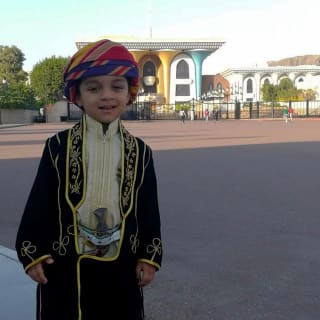
Adventure and Magic in Endless Dunes
Oman's desert landscapes are true natural wonders, captivating with their vast dunes, serene beauty, and rich Bedouin culture. Whether it’s desert safaris, nights under the starry sky, or encounters with centuries-old Bedouin traditions, each desert offers unforgettable experiences. These landscapes are not just adventure playgrounds but also a testament to a deeply rooted culture. Below, we introduce the five most impressive deserts of Oman, each with its own unique features and adventures.
Wahiba Sands
The Golden Heart of Oman
Wahiba Sands, also known as Sharqiya Sands, is one of the most famous deserts in Oman. Located about three hours from Muscat, this sea of dunes stretches over 12,500 square kilometers. With dunes reaching up to 100 meters in height and shimmering in shades of gold to reddish-orange, Wahiba Sands offers a picturesque backdrop, especially during sunrise and sunset.
Landscape
Wahiba Sands is renowned for its spectacular sand dunes that gently wave across the landscape. Unlike many other deserts, this region is static, meaning the dunes barely shift. Thanks to its proximity to the sea, the desert receives enough moisture to support surprisingly diverse flora and fauna. Hidden oases and wadis lie between the massive dunes, which can be explored on foot or by jeep.
Experiences and Activities
For adventurers, Wahiba Sands offers a wide range of activities: from thrilling desert safaris in 4x4 vehicles and camel rides to sandboarding on the steep dunes—there’s something for everyone. A highlight for many is spending a night in one of the traditional desert camps, where you can sleep under a clear, star-filled sky. With minimal light pollution, Wahiba Sands is an ideal spot for stargazing. The best time to visit is between October and March, when temperatures are pleasantly mild.
Nature and Culture
Despite its barren appearance, Wahiba Sands is home to an astonishing variety of life. Over 200 species of animals, including gazelles, desert foxes, and various reptiles, call this desert home. The Bedouin culture is deeply intertwined with the desert. The Bani Wahiba tribes, after whom the desert is named, have lived here for centuries and maintain a rich tradition of hospitality, offering travelers a fascinating insight into desert life.
Rub Al Khali
The Empty Quarter of Extremes
Rub Al Khali, also known as “The Empty Quarter,” is the largest continuous sand desert in the world, stretching across parts of Oman, Saudi Arabia, the UAE, and Yemen. Covering around 650,000 square kilometers, it is one of the most extreme landscapes on Earth. Rub Al Khali is dominated by towering sand dunes, some rising up to 250 meters, and scorching temperatures that can exceed 130°F (55°C) in the summer.
Landscape
Rub Al Khali offers an almost endless expanse of sand dunes that stretch for hundreds of kilometers. These dunes, some of the tallest in the world, range in color from golden yellow to reddish-orange. The climate is extremely dry, with droughts that can last up to ten years. Despite these harsh conditions, the desert is marked by unique geological formations like salt flats and remnants of ancient lakes, giving it great geological significance.
Experiences and Activities
For thrill-seekers, Rub Al Khali offers unique experiences: adrenaline-pumping desert safaris across the giant dunes, traditional camel rides, or exciting sandboarding are all popular here. Stargazing is another highlight, as Rub Al Khali is one of the world’s best places to observe the night sky due to the low light pollution. Visitors can also stay in luxurious desert camps or get a close look at Bedouin life.
Nature and Culture
Despite its extreme conditions, Rub Al Khali is home to a remarkable diversity of flora and fauna, including endemic species such as the Arabian oryx and the Rub Al Khali hare. For centuries, Bedouin tribes have called this desert home, with deep ties to the region. Archaeological sites like the Wabar Crater and the legends surrounding the lost city of Ubar make Rub Al Khali a place of great cultural and historical significance. Beneath its sands lie vast oil and natural gas reserves, which play a central role in the region’s economy today.
Umm As Samim
The Deceptive Salt Flat
Umm As Samim is a vast salt flat in central Oman, bordering Saudi Arabia. This sabkha, covering an area of about 3,000 square kilometers, sits on the eastern edge of Rub Al Khali. The name “Mother of Poisons” hints at the dangerous nature of the area, as the solid salt crust is deceptive, hiding quicksand beneath. The plain serves as a basin into which water flows from the surrounding wadis and mountain regions, making it geologically unique.
Landscape
The surface of Umm As Samim is covered by a solid salt crust that can easily break, revealing treacherous quicksand beneath. The harsh conditions leave the landscape sparsely vegetated, and the salt formations in the plain are striking. This region is one of the driest areas in Oman, and the surrounding wadis carry sediments and water from the mountains into this drainage basin. Historical expeditions have documented evidence of past climate changes in the region.
Experiences and Activities
Due to its unique geology, Umm As Samim offers fewer traditional desert activities than other regions. Desert safaris in 4x4 vehicles and camel rides are possible to explore the vastness of the salt flat. For those seeking a challenge, guided tours through this treacherous landscape are available, though caution is always advised due to the dangerous surface conditions. The best time to visit is between October and April when temperatures are milder.
Nature and Culture
Despite the harsh environment, Umm As Samim supports resilient flora, including salt-tolerant plants like saltbushes and acacias. The wildlife is equally remarkable, with Arabian oryx, sand gazelles, and rare desert birds calling the area home. Culturally, the region has historical significance, as it was linked to ancient caravan routes. Bedouin tribes living nearby maintain close ties to the desert. The famous explorer Wilfred Thesiger was one of the first Europeans to document this region in the 1940s.
Khaluf Desert
The White Desert by the Sea
The Khaluf Desert, also known as the "Sugar Dunes" or "White Desert," is located about 250 miles south of Muscat, stretching along the coast of the Indian Ocean. Famous for its white, sugar-like sand dunes, this desert offers a striking contrast to the deep blue sea. The unique combination of dunes and coastline makes Khaluf Desert one of the most remarkable desert areas in Oman.
Landscape
The white sand dunes of the Khaluf Desert rise gently along the coastline, creating a breathtaking contrast, especially at sunset when the golden tones enhance the scenery. These dunes are particularly soft and constantly shifting, making driving here a challenge. The area remains largely untouched, and the lack of infrastructure underscores the wild, natural character of this desert. A 9-mile (15 km) off-road track along the beach is considered one of the most scenic in Oman.
Experiences and Activities
The Khaluf Desert invites adventurers to exciting experiences. Desert safaris in 4x4 vehicles, sandboarding on the soft dunes, and camping under the starry sky are just some of the activities offered here. A unique highlight is the proximity to the coast—visitors can camp in the desert while enjoying a swim in the Indian Ocean. For cultural insights, a visit to the nearby fishing village of Al Khaluf offers a glimpse into the traditional lifestyle of the fishermen.
Nature and Culture
Though the Khaluf Desert may seem barren, it is home to a surprising variety of flora and fauna. Camels, Arabian gazelles, and a rich birdlife inhabit the region. Culturally, the area is closely connected to the nomadic Bedouin tribes, who have lived in the desert for centuries. Their hospitality and traditional way of life still shape the region today. Despite growing tourism, Khaluf Desert remains a place where nature and culture are uniquely intertwined.
Jiddat al-Harasis
Oman's Wilderness
Jiddat al-Harasis is a vast plateau in central Oman, covering an area of about 27,000 square kilometers. This remote region lies at an elevation of 100 to 150 meters above sea level and is bordered to the east by the Al-Huqf escarpment. Jiddat al-Harasis is known for its geological diversity and its critical role as a habitat for endangered species, especially birds. It is also home to an impressive meteorite strewn field, attracting scientists from around the world.
Landscape
The landscape of Jiddat al-Harasis is a rocky desert, characterized by barren plateaus interspersed with alluvial plains and steep cliffs. Although there are no endless sand dunes here, the region is geologically fascinating: karst limestone dominates the terrain, and there are traces of ancient glacial activity. The Al-Huqf escarpment, which forms the eastern border, drops dramatically into a basin dotted with salt marshes (sabkha) and low hills. Despite the low rainfall, local fog provides surprising moisture, allowing sparse vegetation to grow in some areas.
Experiences and Activities
Adventurous jeep safaris are a popular way to explore the rugged desert landscape of Jiddat al-Harasis. Wildlife viewing is particularly impressive here, with the successful reintroduction of the Arabian oryx. Camping under the clear night sky or staying in traditional Bedouin tents offers an authentic desert experience. The region is also a birdwatcher’s paradise, as it is a key bird sanctuary where rare species like the houbara bustard can be spotted.
Nature and Culture
Despite the harsh conditions, Jiddat al-Harasis supports fascinating flora and fauna. In addition to the endangered Arabian gazelle and rare Arabian wolf population, endemic plants like the prosopis trees and convolvulus shrubs grow in the basins. The region is also home to the Harasis tribe, a Bedouin group that has lived here for centuries with a deep connection to the desert. Their traditional lifestyle, centered on camel breeding and nomadism, continues to thrive in the area, offering visitors a chance to immerse themselves in this proud desert culture.
An Adventure of Endless Dunes and Fascinating Culture
Oman's deserts offer an unparalleled variety of natural experiences, cultural encounters, and adventures. From the majestic dunes of Wahiba Sands to the extreme landscapes of Rub Al Khali and the remote plateau of Jiddat al-Harasis, each desert has its own unique character, captivating travelers with its breathtaking scenery.
Whether on an exciting jeep safari, sandboarding, or spending a peaceful night under the clear starry sky, Oman’s deserts invite you to experience the serene expanse of nature and immerse yourself in the centuries-old traditions of the Bedouins. These regions are not only a paradise for adventurers but also a significant testament to Oman’s fascinating history and culture.
Whichever desert you choose, a visit to Oman’s deserts promises unforgettable experiences that will leave a lasting impression.
Discover Oman with experts who have called it their home
Your dream holiday, tailor-made by experts.
We don't just know Oman from books, we visit the country several times a year to experience the culture, landscape and people first-hand.
From your first enquiry to your return home, we are there for you personally - by phone, email or WhatsApp, whenever you need us. Our trips are as unique as you are: individually planned and provided with exclusive privileges and high-quality arrangements that will make your trip unforgettable.
Experts for your Oman trip








